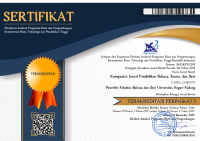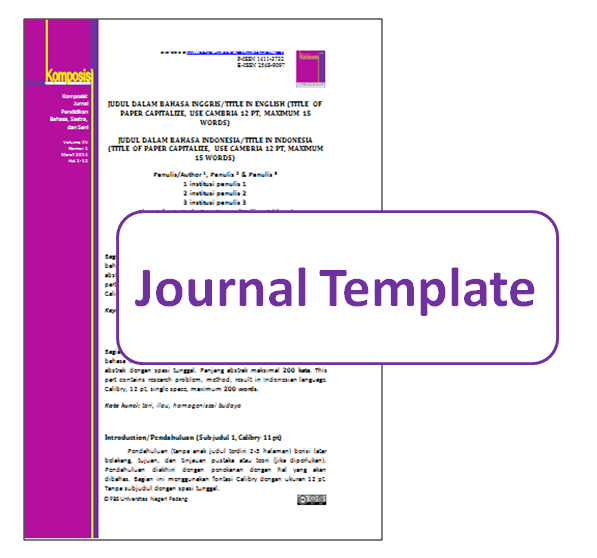Realisasi Active Learning pada Pembelajaran Bahasa Inggris dalam Konteks Pendidikan Keperawatan
Abstract
Distance learning is a challenge in the implementation of health education. The Government of Indonesia recommends the Merdeka Belajar – Kampus Merdeka policy which carries the concept of active learning to be implemented at the college level, including health education. In connection with this, the studies of active learning models in the context of medical education during the COVID-19 period has not been widely reviewed. Therefore, this study aims to explore the implementation of active learning model in English for Professional Nurses subject in a nursing study program in one of the universities in Indonesia. This research employed descriptive research design with qualitative approach. The subject of this study was 1 lecturer. Data and its collection techniques were the learning activities data taken using observations and interviews. The results of this study showed that active learning model can be implemented in asynchronous learning. This research is expected to give overview of active learning in higher education context.
Keywords
Full Text:
PDFReferences
Amir, & Suryana, D. (2018). Active learning teaching and learning model of Entrepreneurship subject at English Education program of Indonesia University of Education. Lembaran Ilmu Kependidikan, 47(1).
Archer, C. C., & Miller, M. K. (2011). Prioritizing active learning: an exploration of gateway courses in political science. The Teacher, 429-434.
Corey, S. H. (2010). Pedagogy and Place: Merging Urban and Environmental History with Active Learning. Journal of Urban History, 36(1), 28–41. https://doi.org/10.1177/0096144209349882
Cosner, S. (2020). A Deeper Look Into Next Generation Active Learning Designs for Educational Leader Preparation. Journal of Research on Leadership Education, 15(3), 167–172. https://doi.org/10.1177/1942775120936301
Darras, K. E., Spouge, R. J., de Bruin, A. B. H., Sedlic, A., Hague, C., & Forster, B. B. (2020). Undergraduate Radiology Education During the COVID-19 Pandemic: A Review of Teaching and Learning Strategies. Canadian Association of Radiologists Journal. https://doi.org/10.1177/0846537120944821
Direktorat Jenderal Pendidikan Tinggi Kementerian Pendidikan dan Kebudayaan. (2020). Buku panduan merdeka belajar – kampus merdeka. Jakarta: Direktorat Jenderal Pendidikan Tinggi Kementerian Pendidikan dan Kebudayaan Republik Indonesia.
Goetze, D. (2015). Hybrid active learning situations: common pools, climate change and course purposes. Simulation & Gaming, 46(6), 792-816. https://doi.org/10.1177/1046878115620089
Hoke, M. M., & Robbins, L. K. (2005). The Impact of Active Learning on Nursing Students’ Clinical Success. Journal of Holistic Nursing, 23(3), 348–355. https://doi.org/10.1177/0898010105277648
Jameson, J. M., Stegenga, S. M., Ryan, J., & Green, A. (2020). Free Appropriate Public Education in the Time of COVID-19. Rural Special Education Quarterly, 39(4), 181–192. https://doi.org/10.1177/8756870520959659
Kaya, H. & Yalniz, N. (2017). Critical Thinking Dispositions of Emergency Nurses in Turkey: A Cross-Sectional Study. Hong Kong Journal of Emergency Medicine, 19(3), p.198-203.
Lewis, S., & Harrison, M. A. (2012). Online delivery as a course adjunct promotes active learning and student success. Teaching of Psychology, 39(1), 72-76. https://doi.org/10.1177/0098628311430641
Luc, J. G. Y., & Antonoff, M. B. (2016). Active Learning in Medical Education: Application to the Training of Surgeons. Journal of Medical Education and Curricular Development. https://doi.org/10.4137/JMECD.S18929
McCoy, L., Pettit, R. K., Kellar, C., & Morgan, C. (2018). Tracking Active Learning in the Medical School Curriculum: A Learning-Centered Approach. Journal of Medical Education and Curricular Development. https://doi.org/10.1177/2382120518765135
Nassaji, H. (2015). Qualitative and descriptive research: Data type versus data analysis. Language Teaching Research, 19(2), 129–132. https://doi.org/10.1177/1362168815572747
Neuwirth, L. S., Jović, S., & Mukherji, B. R. (2020). Reimagining higher education during and post-COVID-19: Challenges and opportunities. Journal of Adult and Continuing Education. https://doi.org/10.1177/1477971420947738
Pavel, E. (2014). Teaching English for Medical Purposes. Bulletin of the Transilvania University of Braşov, 7(2), 39-46.
Pears, M., Yiasemidou, M., Ismail, M. A., Veneziano, D., & Biyani, C. S. (2020). Role of immersive technologies in healthcare education during the COVID-19 epidemic. Scottish Medical Journal, 65(4), 112–119. https://doi.org/10.1177/0036933020956317
Revell, P. (2005 ). The Professionals: better teachers, better schools. Trentham Books.
Roberts, D. (2019). Higher education lectures: From passive to active learning via imagery? Active Learning in Higher Education, 20(1), 63–77. https://doi.org/10.1177/1469787417731198
Roman, A. F. (2014). Methods of designing integrated learning. Journal Plus Education, 11(2), 31-36.
Romanowski, A., Allen, P., & Martin, A. (2019). Educational Revolution: Integrating Concept-Based Curriculum and Active Learning for Mental Health Nursing Students. Journal of the American Psychiatric Nurses Association, 0(00), 1–5. https://doi.org/10.1177/1078390319890031
Setiawan, R., Mardapi, D., Pratama, A., & Ramadan, S. (2019). Efektivitas Blended Learning dalam Inovasi Pendidikan Era Industri 4.0 pada Mata Kuliah Teori Tes Klasik. Jurnal Inovasi Teknologi Pendidikan, 6(2), 148-157. https://doi.org/10.21831/jitp.v6i2.27259
Smart, K. L., & Csapo, N. (2007). Learning by Doing: Engaging Students Through Learner-Centered Activities. Business Communication Quarterly, 70(4), 451–457. https://doi.org/10.1177/10805699070700040302
Smith, K., & Horvath, P. (2014). Active Learning Strategies for Phenotypic Profiling of High-Content Screens. Journal of Biomolecular Screening, 19(5), 685–695. https://doi.org/10.1177/1087057114527313
Srichaiyarat, P., & Lao-Amata, P. (2020). Legal Education During COVID-19 Pandemic: An Experience of a Thai Law School. Asian Journal of Legal Education, 7(2), 228–230. https://doi.org/10.1177/2322005820935753
Tang, P. Y., New, L. M., & Leow, W. Q. (2020). Zooming for cells: Tele-education of histopathology residents during the COVID-19 pandemic. Proceedings of Singapore Healthcare. https://doi.org/10.1177/2010105820944447
Van den Bergh, L., Ros, A., & Beijaard, D. (2014). Improving Teacher Feedback During Active Learning: Effects of a Professional Development Program. American Educational Research Journal, 51(4), 772–809. https://doi.org/10.3102/0002831214531322
Van Deur, P. (2010). Assessing elementary school support for inquiry. Learning Environment Research, 13, 159–172. https://doi.org/10.1007/s10984-010-9070-y
Wiggins, B. L., Eddy, S. L., Grunspan, D. Z., & Crowe, A. J. (2017). The ICAP Active Learning Framework Predicts the Learning Gains Observed in Intensely Active Classroom Experiences. AERA Open. https://doi.org/10.1177/2332858417708567
DOI: https://doi.org/10.24036/komposisi.v22i1.110855
Refbacks
- There are currently no refbacks.
Copyright (c) 2021 Komposisi: Jurnal Pendidikan Bahasa, Sastra, dan Seni

This work is licensed under a Creative Commons Attribution-NonCommercial 4.0 International License.
Komposisi: Jurnal Pendidikan Bahasa, Sastra, dan Seni, a peer-reviewed online journal in languages, literature, and arts education.
Printed ISSN 1411-3732, Online ISSN 2548-9097.
Currently, Komposisi: Jurnal Pendidikan Bahasa, Sastra, dan Seni is indexed by:
Published by:
Universitas Negeri Padang (UNP)
Address: Faculty of Languages and Arts (FBS) Universitas Negeri Padang.
Jl Prof. Dr. Hamka Air Tawar Barat, Padang - West Sumatera -Indonesia
Telp/Fax. +62751 7053363
Home page: http://ejournal.unp.ac.id/index.php/komposisi | e-mail:komposisi.fbsunp @ fbs.unp.ac.id | cc: havid_a @ fbs.unp.ac.id
slot resmi
situs toto
situs toto toto slot
Wanita Subang Beli mobil dari Nolimit city
Gatot kaca Buat TKW Jadi jutawan
Rahasia sukses bermain Mahjing wins
rahasia sukses bermain mahjong ways
div>











